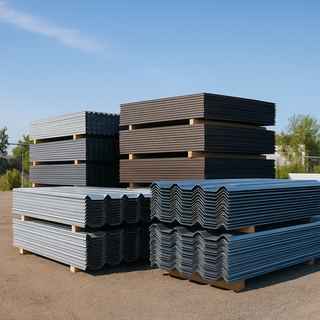How Metal Roofing Performs in Coastal and Salt-Air Environments
Protecting Your Home from the Sea, One Panel at a Time
Living near the coast brings many benefits—ocean views, salt-kissed breezes, and that unmistakable vacation-every-day feeling. But for homeowners in coastal and salt-air environments, one major challenge persists: protecting their property from corrosion, salt, wind, and moisture.
When it comes to roofing, metal is often the preferred choice in these regions—but not all metal roofs are created equal. In this comprehensive guide, we explore how metal roofing stands up to the coastal elements, which materials perform best, and what you need to know to ensure your roof lasts for decades.
Why Coastal Environments Are So Demanding on Roofs
Coastal homes are bombarded with conditions that deteriorate standard roofing systems much faster than inland properties:
-
Salt-laden air that accelerates corrosion
-
High winds from hurricanes and tropical storms
-
Moisture saturation and humidity year-round
-
UV exposure that weakens paint and sealants
These stressors can quickly degrade asphalt shingles, wood shakes, and even poorly coated metal roofing systems—making material selection, coating technology, and proper installation critical for coastal builds.
Why Metal Roofing is Ideal for Coastal Regions
Unlike porous or organic roofing materials, metal roofing offers:
-
High corrosion resistance (when properly selected)
-
Exceptional wind uplift ratings
-
Non-combustibility for wildfire-prone coastal areas
-
Minimal maintenance
-
Superior longevity—often 40 to 70+ years
The trick is to choose the right metal, coating, and installation system for the salty coastal environment.
Top Metal Roofing Materials for Coastal Environments
✅ Aluminum Roofing
Best Overall for Saltwater Resistance
-
Corrosion Rating: Excellent (doesn’t rust)
-
Weight: Lightweight, reduces structural load
-
Coatings Needed: Typically painted or anodized for color
-
Lifespan: 40–70+ years
Aluminum does not contain iron, so it cannot rust—making it the best choice for homes within 1,500 feet of the ocean. It forms a natural oxide layer that protects it from further corrosion, even without heavy coating systems.
Ideal for: Beachfront homes, barrier islands, and marine-adjacent properties.
✅ Stainless Steel Roofing
Most Durable, Premium Option
-
Corrosion Rating: Outstanding with marine-grade (316) stainless
-
Strength: Incredibly strong and dent-resistant
-
Cost: High-end, luxury-tier pricing
-
Appearance: Can be polished, brushed, or painted
While stainless steel is more common in commercial builds, it’s ideal for custom homes that demand strength and aesthetic appeal without compromising longevity.
⚠️ Galvalume-Coated Steel
Reliable—but with limitations
-
Corrosion Rating: Very good (except at cut edges in salty air)
-
Coating: Zinc and aluminum alloy protective layer
-
Cost: More affordable than aluminum or stainless
-
Caution: Not ideal for homes within a few miles of the shore unless properly coated
Note: Galvalume is often not warranted in direct coastal applications. For inland coastal areas (5+ miles from oceanfront), it can still be a great option with proper paint systems.
❌ Bare Steel or Galvanized Roofing
Avoid in Coastal Settings
-
Corrosion Rating: Poor in salt air
-
Lifespan: Rapid rusting and coating failure
-
Use Case: Inland areas only
Even if galvanized steel is treated or painted, salt accelerates the breakdown of the zinc layer, leading to rust and premature failure.
Key Coating Systems for Coastal Metal Roofs
Choosing the right paint and coating system is just as important as selecting the metal itself.
🔷 PVDF Coatings (Kynar 500® / Hylar 5000®)
-
Best-in-class UV resistance
-
High resistance to chalking, fading, and corrosion
-
Backed by long-term warranties
-
Ideal for aluminum and Galvalume panels
🔷 Anodized Aluminum
-
Chemical finish that integrates into the metal
-
Scratch-resistant and fade-resistant
-
No chipping or peeling like paint
-
Modern architectural look
Wind and Storm Protection
Coastal homes need roofs that can withstand:
-
120+ mph winds
-
Driving rain and horizontal water intrusion
-
Debris impact
Recommended Profiles:
-
Mechanically Seamed Standing Seam Panels (double-locked)
-
Interlocking Metal Shingles or Tiles
-
Hidden Fastener Systems
These designs offer:
-
Superb wind uplift ratings
-
Fewer seams and penetration points
-
Tighter panel connections and waterproof seals
Maintenance Considerations in Salt-Air Environments
Even the best materials need care in coastal zones. Here's how to extend the life of your metal roof:
Regular Maintenance Checklist:
-
Rinse roof with fresh water 1–2 times per year (or after storms)
-
Inspect for corrosion, especially at cut edges and fasteners
-
Clear salt deposits and debris from valleys, gutters, and seams
-
Touch up coatings at scratches or chips promptly
-
Trim back vegetation to prevent abrasion and moisture retention
Cost Comparison: Coastal Metal Roofing
| Metal Type | Installed Cost (per sq. ft.) | Salt Resistance | Typical Lifespan |
|---|---|---|---|
| Aluminum | $9–$14 | Excellent | 40–70+ years |
| Stainless Steel | $12–$20 | Excellent | 50–100+ years |
| Galvalume Steel | $7–$11 | Moderate | 30–50 years* |
| Galvanized Steel | $5–$9 | Poor | <20 years (coast) |
*Lifespan can decrease significantly within a few miles of the ocean
Case Study: Aluminum Standing Seam Roof on a Coastal Home
A Florida homeowner living 800 feet from the Gulf installed a Kynar-coated aluminum standing seam roof in 2012. Thirteen years later, the roof remains pristine, with zero corrosion, minimal maintenance, and reflects solar heat—lowering summer cooling bills by 15%.
Their choice to avoid Galvalume and invest in aluminum paid off in long-term protection, performance, and peace of mind.
Final Thoughts: Is Metal Roofing Right for Your Coastal Home?
If you're near the ocean, metal roofing isn’t just an option—it’s a necessity for lasting protection.
✅ Choose aluminum or stainless steel if you’re within 1 mile of saltwater.
✅ Invest in Kynar/PVDF coatings for color retention and corrosion resistance.
✅ Use seamless or mechanically seamed panels for wind protection.
✅ Schedule regular rinsing and inspections to maximize your roof's lifespan.
Whether you're protecting your vacation getaway or primary residence, a properly installed metal roof is one of the best long-term investments you can make in a coastal or salt-air environment.






